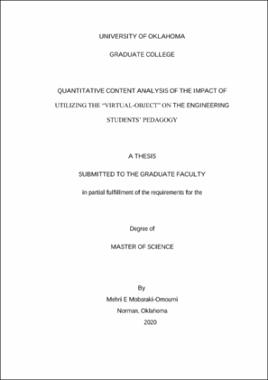| dc.description.abstract | The objective of this study was to investigate the impact of utilizing the specially designed "Virtual-Object" and project-based learning instruction in the Thermodynamics course on engineering students' performance.
Rubric based grading and Quantitative data analysis have been used as two different evaluation methods in order to identify the preferred evaluation method based on learning goals. Also, this research observed the possible complementary effect of applying different assessment methods on students' pedagogy.
The students who enrolled in the Thermodynamics course in the sophomore-level at the University of Oklahoma for three consecutive years (2017 to 2019) were asked to design a power plant as a class project. The specially designed Virtual-Object (V-object), by Virginia Tech University research group, was provided to the students in 2018 and 2019, where the students in 2017 were taught the course without using the V-object. Additionally, some assessment methods were applied to the students who enrolled in 2019.
The mean value of grades among the students was used as a descriptive measure in Rubric based grading method. This mean value among students enrolled in 2017 was 12.64 on 1 to 20 scale, and 14.27 and 17.91 in classes of 2018 and 2019, respectively. The results of the statistical analysis of the normalized mean of each category in the quantitative content analysis were consonant with the results of rubric-based grading and supported the improvements in the performance of the students in most of the defined categories. Content analysis is the preferred method and provides more detailed data in project-based learning when we want to evaluate cognitive thinking or the high level of educational goals, evaluating or creating; however, it is probably not a suitable method in analyzing the basic levels of learning goals like remembering. | en_US |
